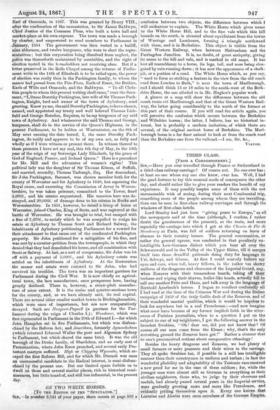RE TWO WHITE HORSES.
[To THE EDITOR OF THE "SPECTATOR."] Sgt, —41 number 2,041 of your paper, there occurs at page 889 a confusion between two objects, the difference between which I will endeavour to explain. The White Horse which gives name to the White Horse Hill, and to the fine vale which this hill bounds on the south, is situated about equidistant from the towns of Wantage and Lambourn, forming ;I', triangle northward with them, and is in Berkshire. This object is visible from the Great Western Railway, when between Shrivenham and the Farringdon Junction. It is, no doubt, of great antiquity, giving its name to the hill and vale, and is marked in old maps. It has lOst all resemblanoe to a horse, its legs, tail, and nose being elon- gated by rain running down ; it has now the appearance of a chalk- pit, or a portion of a road. The White Horse which, as you say, " used to form so striking a feature in the view from the old coach road from London to Bath," is near the town of Marlborough, and I should think 15 or 18 miles to the south-west of the Berk- shire Horse, the one alluded to in Mr. Hughes's popular work.
A glance at a map will show the difference between the old coach route via Marlborough and that of the Great Western Rail- way, the latter going considerably to the north of the former at this part of their course. If you will read the article again, you will perceive the confusion which occurs between the Berkshire and Wiltshire horses ; the latter, I believe, has no historical in- terest, but is probably a modern imitation, of which there are several, of the original ancient horse of Berkshire. The Marl- borough horse is a far finer animal to look at from the coach road than the Berkshire one from the railroad.—I am, Sir, &e.,
VIATOR.






























 Previous page
Previous page